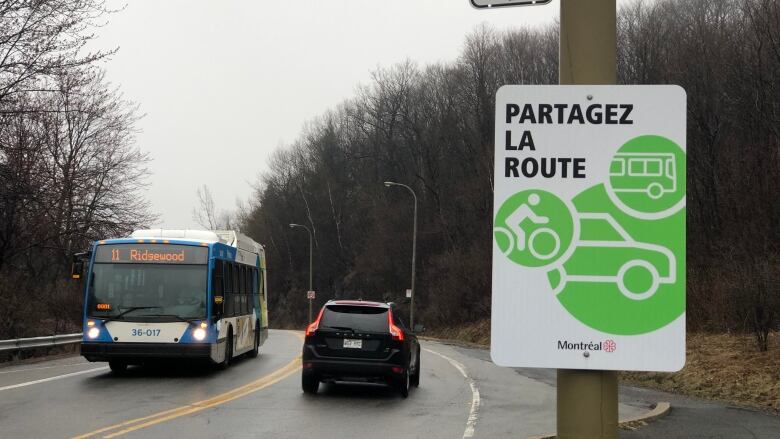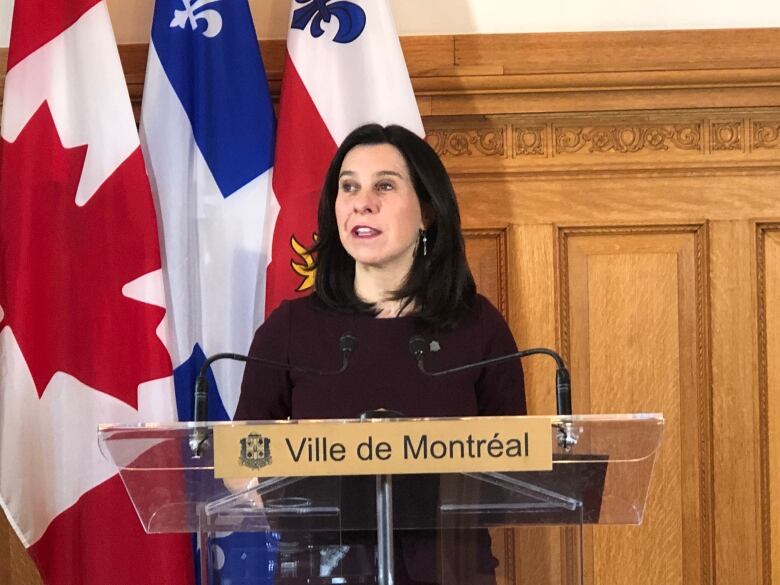Montreal to allow traffic over Mount Royal, but it will no longer be a 'highway,' mayor says
Public consultations office recommends maintaining traffic on Camillien-Houde Way

Montreal Mayor Valrie Plante says Camillien-Houde Way will stay open to private vehicles all year long, but it will no longer serve as a "highway" over the Mount Royal.
The mayor's announcement comes after the Office de consultation publique de Montral (OCPM) recommended it stay open.
The independent body released a report Thursday onthe results of a pilot project that closed a stretch of the road near Beaver Lake last year.
"We believe in safety first and we will take any measures to ensure it," said Plante, noting the pilot project was launched in the wake of Clment Ouimet's death in 2017.
The young cyclist killed when he collided with an SUV making an illegal U-turn near the lookout at the northeast end of Camillien-Houde.
"We intend to follow the recommendations of the OCPM," she said.
"The OCPM report is clear, Camillien-Houde must take on a new [purpose]. Camillien-Houde will become a road that will be safe for all users."
Plante reminded residents that, back in December, her administration vowed to respect the OCPM's findings.
Temporary measures will be put in place as early as this summer, she said. Traffic will be allowed, but "today's report officially marks the end of Camillien-Houde as a highway."
Congestion spread out into surrounding streets
The OCPM found that when cars moved to alternate routes, it causedcongestion on surrounding roadways.The closure also created a perception accessing the mountain was harder.
Based on the data provided and the opinions expressed, the pilot project didn't seem to "solve the problem of security and sharing of the road," said Dominique Ollivier, head of the OCPM, on CBC Montreal's Daybreak.
"We couldn't recommend to go ahead with permanent measures" like closing it for good, she explained.
Instead, her office recommended that motor traffic be maintained alongCamillien-HoudeWayandRemembrance Roadwhile providing for the "redevelopment of this axis as a pleasure route."
The public consultation quickly became the largest in the city's history as thousands of people shared their opinion with the OCPMon the project, and most of those opinions were not favourable to closing the popular route.

The closure raised the ire of motorists who regularly use the road as a shortcut between the Cte-Des-NeigesNotre-Dame-De-Grce and Plateau-Mont-Royal boroughs.
Buses, taxis, emergency vehicles and otherswere still allowed to use Camillien-Houde. Planters and signswere put in place to indicate the street's closure and hundreds of tickets were doled out to those who ignored the rules.
Looking for ways to improve route
The OCPM'sreport is based on citizen opinion and data that the city collected over the run of the pilot project, Olliviersaid.
She saidthe city should be looking at ways to improve the route over the mountain andensure there is public transportation available.
It's also important, she added, that "all the different landmarks on the mountainare accessible before we can think about just shutting it down to through traffic."
Pilot project had its perks, mayor says
While there were complaints, the project also generated some positive effects, Plante said.
There were no collisionson Camille-Houde Way throughout the pilot project, she said, and officials saw a 75 per cent reduction in the number of cars on the mountain.
Motorists were also driving slower, dropping their average driving speed from 50 to 40 kilometres per hour.
This, Plante said, significantly boosted cycling and pedestrian safety.
Opposition leader Lionel Perez is reacting, saying the pilot project was a total fiasco, something he says theyve been saying since the beginning
—@katemckenna8The city is now working on a long-term plan, but nothing will be done to the detriment of the mountain or the safety of its visitors, she said.
"I have always said I would be the mayor of all Montrealers and I would listen to what they had to say," she said.
Speaking to reporters on Thursday, opposition leader Lionel Perez said the closurewas a "total fiasco" and that it's what he's saidsince the beginning.
Not everybodyagainst the closure
Pierre Ernst, who was out for a run on the Mount Royal Thursday, saidhe finds the OCPM's recommendations "unfortunate" because there is no need to cross over the mountain by car.
"I thought we were going in a direction where we were promoting biking and running and walking and it's unnecessary," he said.

"It sure makes me feel bad for that young kid who got killed for no reason," he added, referring to the death ofOuimet.
After living on both sides of the mountain, Ernst said and going around it is "not that big of a deal. Especially if they fix the streets a little."
With files from CBC Montreals Daybreak and Kate McKenna












_(720p).jpg)


 OFFICIAL HD MUSIC VIDEO.jpg)
.jpg)



























































































